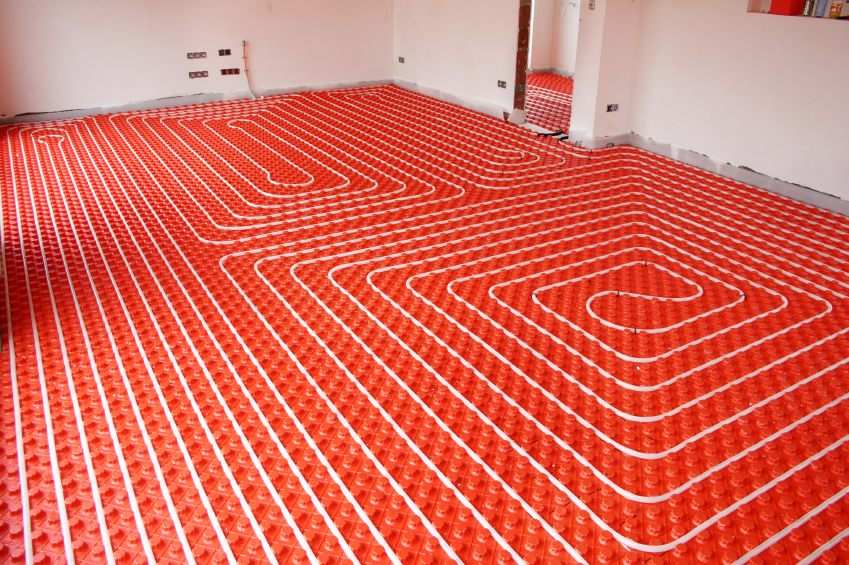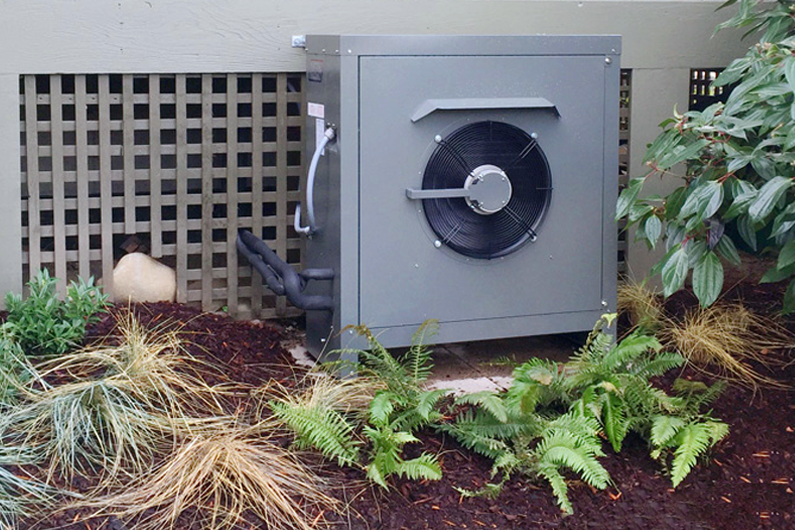Choosing the right head pump for your home is not an easy feat. There are many factors to consider including initial cost, efficiency, monthly cost, and comfort. You’ll also need to take into consideration what type of distribution system and energy supply source you have available.
As part of a new series on choosing a heat pump for your home, today we’re going to focus on choosing the right heat pump for radiant in-floor heating.
Radiant in-floor heating, also sometimes called underfloor heating, is gaining popularity in Canada and is an efficient, silent, and comfortable way to heat your home. There are two primary types of modern in-floor heating: electric resistance heating, and hydronic heating. We’re going to focus on hydronic heating.
Hydronic in-floor heating is achieved by casting piping into concrete and circulating a heated fluid through the piping. The heated fluid then radiates heat into the concrete, warming your floors and your home. This method of home heating is efficient, silent, and very comfortable.
There are many ways to heat the fluid, from an electric boiler, by using fossil fuels, or by using a heat pump. If you choose to use a heat pump, there are two primary types you can use: a water to water heat pump (such as the Nordic W Series), or an air to water heat pump (like the Nordic ATW Series).
These two types of heat pumps each have their pros and cons and are best suited to certain homes. Here are the different factors you need to consider when choosing between these two types of heat pumps:
Initial Cost
The major difference between the W Series heat pump and the ATW Series heat pump is how they harvest their heat. The W Series heat pump is a geothermal heat pump which means it harvests its heat from the ground. It does this by extracting heat from a geothermal ground loop. A ground loop is plastic piping buried in the earth with a food-grade antifreeze solution circulating through it. In the winter, the liquid in the pipes absorbs the low-grade heat from the ground, and the geothermal heat pump extracts that heat and transfers it into your home.
Installing a ground loop requires excavation or vertical borehole drilling, depending on how much space is available to you. This adds to the geothermal heat pump cost.
In contrast, an air source heat pump harvests heat from the outdoor air. There is no geothermal ground loop, which means no excavation or vertical drilling. Instead, the part of the heat pump that harvests heat sits outside the home on a concrete slab, as pictured below.
Since there is no excavation, the initial cost of an air source heat pump is less than a geothermal heat pump. The cost for the indoor components including the hydronic piping and the indoor portion of both types of heat pumps is about the same.
Ability
Both the W Series heat pump and the ATW Series heat water up to 120°F for radiant in-floor heating. Both units are fully reversing to provide chilled water for air conditioning via a hydronic air handler, and both units come with a desuperheater as standard equipment for domestic hot water preheating. In terms of what the heat pumps can provide, they are very similar.
Efficiency
A heat pump’s efficiency is how much heat it can produce compared to the energy required to run it. We measure a heat pump’s efficiency using a formula called coefficient of performance (COP). A heat pump’s COP is a measure of the heat pump’s output compared to the amount of energy required to produce that output. You can calculate heat pump COP by measuring its inputs and outputs in a laboratory setting, and we’ve measured that the average geothermal heat pump has a COP of 4.00, while the average air source heat pump has a COP that goes up and down, but averages around 2.9 for the whole year’s temperature fluctuations.
As a result, you can safely say that a geothermal heat pump is more efficient than an air source heat pump.
Monthly Cost
We now know that, on average, an air source heat pump is less costly to install up front, but what about the month to month costs? Again, this is where efficiency comes in.
We know that the ATW Series heat pump is a little less efficient on average than the W Series heat pump. That means it needs to work harder to put out the same amount of heat. When the ATW Series works harder, it consumes more electricity, which will make it a little more expensive to run than the W Series.
If you choose an air source heat pump to replace your current heating system, you can expect a less dramatic reduction in your utility bills, especially in the dead of winter when temperatures are very low, and the unit may have to run on backup heat for a few days per year, which has a COP of 1.0.
Longevity
Because geothermal heat pumps are housed completely indoors and underground, they last a long time. All of the major components are inside the home in a temperature-controlled environment such as a basement or mechanical room. You can expect your geothermal heat pump to last up to 20 years.
In comparison, air source heat pumps also have very good longevity, with a few caveats. Our uniquely designed ATW Series heat pump has all major components indoors including the compressor and control board. The only parts that are in the outdoor unit are an air coil, electronic expansion valve, and fan. While we manufacture our outdoor unit out of the most robust components we can find, they are subject to the wear and tear of the outdoor elements. They should still last a long time, but some maintenance will be required on the outdoor portion of the machine.
Comfort
Both types of heat pumps are designed to provide extremely comfortable and quiet hydronic heating for your home. With both systems, you will receive the same, highly comfortable underfloor heating in your home. In this respect the two heat pumps are equal.
Find out how a heat pump system could help you save on your monthly utility bills. Find a dealer for a free, personalized quote!



